Themed collection Halide Perovskite Nanocrystals

Nanoscale & Nanoscale Advances joint themed collection on halide perovskite nanocrystals
This themed issue includes a collection of articles on halide perovskite nanocrystals.

Nanoscale, 2019,11, 8648-8650
https://doi.org/10.1039/C9NR90092F
Blue perovskite light-emitting diodes: progress, challenges and future directions
We report on the progress, challenges and future directions of blue perovskite light-emitting diodes to facilitate their further development.

Nanoscale, 2019,11, 2109-2120
https://doi.org/10.1039/C8NR09885A
Advances in lead-free double perovskite nanocrystals, engineering band-gaps and enhancing stability through composition tunability
In this topical review, we have focused on the recent advances made in the studies of lead-free perovskites in the bulk form and as nanocrystals. We highlight how nanocrystals can serve as model systems to explore the schemes of cationic exchange, doping and alloying for engineering the electronic structure of double perovskites.

Nanoscale, 2019,11, 8665-8679
https://doi.org/10.1039/C9NR01031A
O2 as a molecular probe for nonradiative surface defects in CsPbBr3 perovskite nanostructures and single crystals
Surface defects and environmental conditions affect the physical properties of CsPbBr3 perovskites differently, based on the materials dimensionality, despite their ‘defect tolerant’ electronic structure.
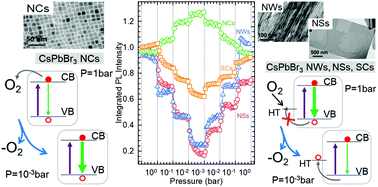
Nanoscale, 2019,11, 7613-7623
https://doi.org/10.1039/C9NR01133A
Pressure-induced fluorescence enhancement of FAαPbBr2+α composite perovskites
FAPbBr3 crystals were stabilized by the endotaxy passivation by FA4PbBr6 during high pressure compression.
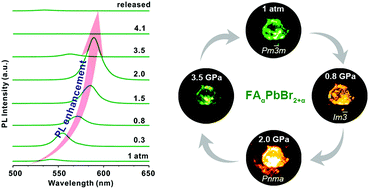
Nanoscale, 2019,11, 5868-5873
https://doi.org/10.1039/C8NR09780A
Emergence of lead halide perovskite colloidal dispersions through aggregation and fragmentation: insights from the nanoscale to the mesoscale
The growth of colloidal perovskite precursors by changing chemical composition, concentration and the impact on resultant thin-film morphologies is explored.
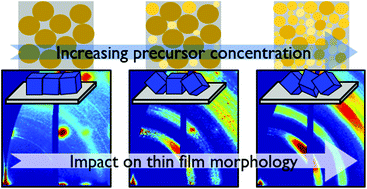
Nanoscale, 2019,11, 3495-3499
https://doi.org/10.1039/C8NR09853K
Observation and implication of halide exchange beyond CsPbX3 perovskite nanocrystals
Internanocrystal halide exchange between CsPbX3 perovskite nanocrystals and cesium based non-perovskite nanocrystals has been studied for the first time.
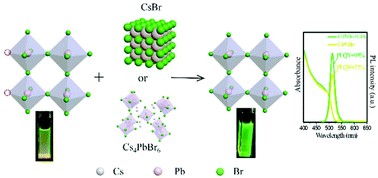
Nanoscale, 2019,11, 3123-3128
https://doi.org/10.1039/C8NR10150G
Novel optoelectronic rotors based on orthorhombic CsPb(Br/I)3 nanorods
An innovative nanorotor based on halide perovskite nanorods is proposed here. The HP nanorods are suspended in a non-conductive fluid and a rotating electric field is applied. When light is applied, photogenerated charge carriers will enhance the electric torque produced by the rotating field which eventually overpowers the Brownian motion and forces the nanorods to rotate.
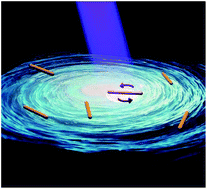
Nanoscale, 2019,11, 3117-3122
https://doi.org/10.1039/C8NR06768F
Critical role of metal ions in surface engineering toward brightly luminescent and stable cesium lead bromide perovskite quantum dots
A facile metal ions-assistant ligand surface engineering strategy to synchronously boost photoluminescence quantum yield and stability of CsPbBr3 PQDs.
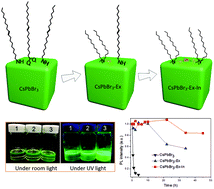
Nanoscale, 2019,11, 2602-2607
https://doi.org/10.1039/C8NR09350D
Engineering ultrafast charge transfer in a bismuthene/perovskite nanohybrid
0-Dimensional (0D) CsPbBr3 QDs were integrated with 2D bismuthene to obtain a 0D/2D nanohybrid with tunable charge transfer efficiency.
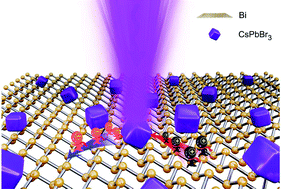
Nanoscale, 2019,11, 2637-2643
https://doi.org/10.1039/C9NR00058E
Room temperature precipitated dual phase CsPbBr3–CsPb2Br5 nanocrystals for stable perovskite light emitting diodes
A facile and easily scaled-up ligand assisted precipitation route has been reported to produce highly photoluminescent and stable dual-phase CsPbBr3–CsPb2Br5 NCs for improving the stability of PeLEDs.
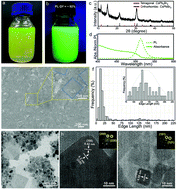
Nanoscale, 2018,10, 19262-19271
https://doi.org/10.1039/C8NR06879H
The role of gold oxidation state in the synthesis of Au-CsPbX3 heterostructure or lead-free Cs2AuIAuIIIX6 perovskite nanoparticles
The oxidation state of the Au ions determines whether cation exchange or gold deposition occurs when an Au salt is added to solutions of all-inorganic cesium lead halide perovskite nanocrystals.
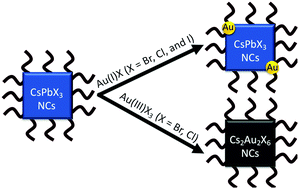
Nanoscale, 2019,11, 18109-18115
https://doi.org/10.1039/C9NR07222E
Low-dimensional perovskite nanoplatelet synthesis using in situ photophysical monitoring to establish controlled growth
CsPbBr3 nanoplatelets are synthesized with fine control over size, thickness and optical properties. In situ photoluminescence measurements are used to optimize platelet growth.
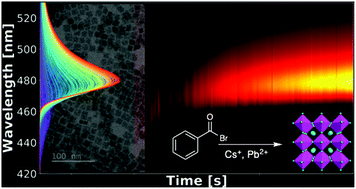
Nanoscale, 2019,11, 17262-17269
https://doi.org/10.1039/C9NR04010B
All-polymer methylammonium lead iodide perovskite microcavities
We demonstrate state of the art polymer-perovskite microcavities obtained by protecting the polymer photonic structure from a broad-range perovskite solvent with a perfluorinated layer.
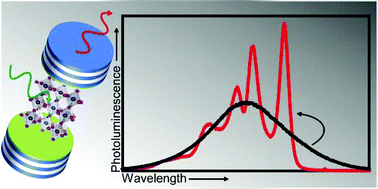
Nanoscale, 2019,11, 8978-8983
https://doi.org/10.1039/C9NR01422E
Simple fabrication of layered halide perovskite platelets and enhanced photoluminescence from mechanically exfoliated flakes
Bright blue-emitting 2D layered perovskites based on single octahedral planes are fabricated with different spacer molecules, and acetone as solvent.
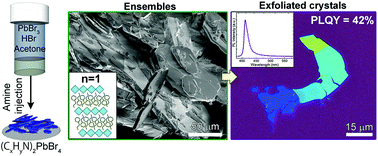
Nanoscale, 2019,11, 8334-8342
https://doi.org/10.1039/C9NR00638A
Flexible photodetectors based on reticulated SWNT/perovskite quantum dot heterostructures with ultrahigh durability
Recently, single-walled carbon nanotube (SWNT) films have been regarded as a promising channel material for flexible photodetectors due to their high intrinsic carrier mobility, conductivity, and mechanical flexibility.
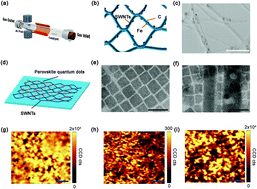
Nanoscale, 2019,11, 8020-8026
https://doi.org/10.1039/C8NR08026G
Beyond quantum confinement: excitonic nonlocality in halide perovskite nanoparticles with Mie resonances
Halide perovskite nanoparticles with sizes larger than 20 nm have demonstrated pronounced nonlocal excitonic properties governed by Mie modes.
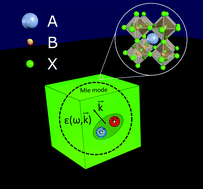
Nanoscale, 2019,11, 6747-6754
https://doi.org/10.1039/C8NR09837A
Scalable fabrication of high-quality crystalline and stable FAPbI3 thin films by combining doctor-blade coating and the cation exchange reaction
This study highlights the importance of a scalable blade coating technique and the ion exchange reaction in fabricating high-quality perovskite thin films.

Nanoscale, 2019,11, 5989-5997
https://doi.org/10.1039/C8NR10267H
Photoinduced Mn doping in cesium lead halide perovskite nanocrystals
Manganese ions were incorporated into CsPbX3 nanocrystals with their morphology and size preserved using a photo-induced post-synthesis doping method.
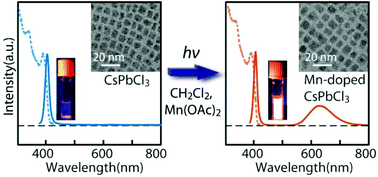
Nanoscale, 2019,11, 5247-5253
https://doi.org/10.1039/C8NR10439E
Highly luminescent red emissive perovskite quantum dots-embedded composite films: ligands capping and caesium doping-controlled crystallization process
A ligand and Cs+ were introduced to reduce the solubility between precursors and polymers, resulting in highly luminescent composite films.
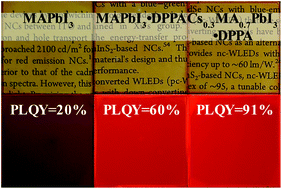
Nanoscale, 2019,11, 4942-4947
https://doi.org/10.1039/C8NR10036E
Postsynthesis Mn-doping in CsPbI3 nanocrystals to stabilize the black perovskite phase
Postsynthesis Mn-doping elucidates the role of lattice contraction and surface passivation in stabilizing the black phase of CsPbI3 nanocrystals under ambient conditions.
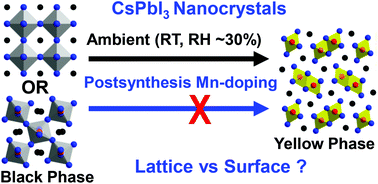
Nanoscale, 2019,11, 4278-4286
https://doi.org/10.1039/C9NR00248K
Single pot synthesis of indirect band gap 2D CsPb2Br5 nanosheets from direct band gap 3D CsPbBr3 nanocrystals and the origin of their luminescence properties
The origin of the luminescence properties of CsPb2Br5 is ascribed to the presence of different amorphous lead bromide amine complexes.
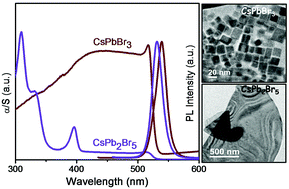
Nanoscale, 2019,11, 4001-4007
https://doi.org/10.1039/C8NR09349K
The luminescence properties of CsPbxM1−xBr3 perovskite nanocrystals transformed from Cs4PbBr6 mediated by various divalent bromide MBr2 salts
A novel high concentration doping method, Cs4PbBr6 reacting with MBr2 (ZnBr2, MnBr2, EuBr2) and transforming to CsPbxM1−xBr3 nanocrystals, was developed.
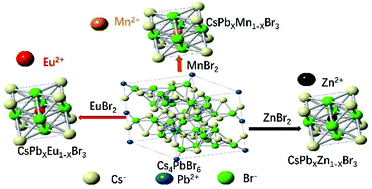
Nanoscale, 2019,11, 4008-4014
https://doi.org/10.1039/C8NR09845J
Photoreversible luminescence switching of CsPbI3 nanocrystals sensitized by photochromic AgI nanocrystals
A reversible fluorescence switching of CsPbI3 nanocrystals (NCs) was realized using photosensitive AgI NCs under light on/off and applied for a rewritable platform.
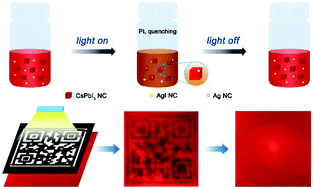
Nanoscale, 2019,11, 3193-3199
https://doi.org/10.1039/C8NR09783F
The photoluminescence mechanism of CsPb2Br5 microplates revealed by spatially resolved single particle spectroscopy
Three different emission centers with different photoluminescence lifetimes were identified in CsPb2Br5 microplates with the primary contribution from embedded CsPbBr3 nanocrystals.

Nanoscale, 2019,11, 3186-3192
https://doi.org/10.1039/C8NR10110H
Effect of chloride substitution on interfacial charge transfer processes in MAPbI3 perovskite thin film solar cells: planar versus mesoporous
Electron injection from perovskite to planar TiO2 accelerates with chloride addition, in mesoporous TiO2 carrier recombination is slowed.
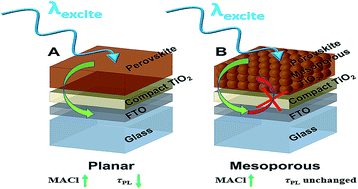
Nanoscale Adv., 2019,1, 827-833
https://doi.org/10.1039/C8NA00317C
Room-temperature high-performance CsPbBr3 perovskite tetrahedral microlasers
Room-temperature high performance tetrahedral microlasers based on CsPbBr3 perovskite single crystals with triangular symmetry are demonstrated.
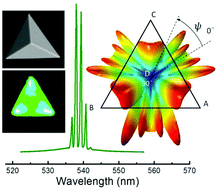
Nanoscale, 2019,11, 2393-2400
https://doi.org/10.1039/C8NR09856E
Effective blue-violet photoluminescence through lanthanum and fluorine ions co-doping for CsPbCl3 perovskite quantum dots
Co-doping of cation (La3+) and anion (F−) ions is a feasible method to improve the optical properties of CsPbCl3 QDs, and high photoluminescence quantum yield of 36.5% is achieved in CsPb(Cl0.7F0.3)3:La3+ QDs.

Nanoscale, 2019,11, 2484-2491
https://doi.org/10.1039/C8NR09794A
Highly stable enhanced near-infrared amplified spontaneous emission in solution-processed perovskite films by employing polymer and gold nanorods
Highly stable enhanced near-infrared amplified spontaneous emission in solution-processed perovskite films by employing polymer and gold nanorods.
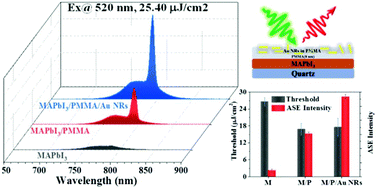
Nanoscale, 2019,11, 1959-1967
https://doi.org/10.1039/C8NR08952C
A systematic study of the synthesis of cesium lead halide nanocrystals: does Cs4PbBr6 or CsPbBr3 form?
An amine-free method is used to systematically investigate the role of Cs, Pb and Br in hot-injection synthesis.
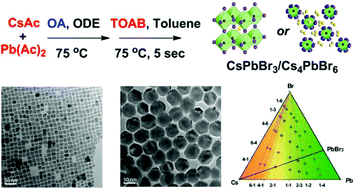
Nanoscale, 2019,11, 1784-1789
https://doi.org/10.1039/C8NR08116F
Broadband ultrafast nonlinear optical studies revealing exciting multi-photon absorption coefficients in phase pure zero-dimensional Cs4PbBr6 perovskite films
Lead halide perovskite nanocrystals have recently demonstrated promising nonlinear optical properties such as strong two-photon absorption, three-photon absorption, four-photon absorption and their respective cross-sections.
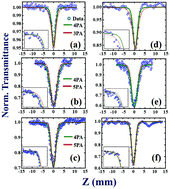
Nanoscale, 2019,11, 945-954
https://doi.org/10.1039/C8NR06969G
About this collection
Guest Edited by Dr Lakshminarayana Polavarapu (Ludwig Maximilian University of Munich, Germany), Professor Qiao Zhang (Soochow University, China) and Professor Roman Krahne (Italian Institute of Technology, Italy).
Metal halide perovskite nanocrystals have emerged as an attractive new class of semiconductor materials owing to their excellent optical and optoelectronic properties. Compared to their bulk counterparts, the nanoscale dimensions and tunable morphology of halide perovskite NCs provide more possibilities to tailor their optical properties and expands their use in optoelectronic devices. Over the past several years, tremendous achievements have been made not only in preparing NCs with well-defined morphology and novel properties, but also in understanding their growth mechanism as well as their potential use in various applications. This themed collection of Nanoscale aims at providing a platform for recent developments in the expanding field of perovskite NCs. The following topics are covered in this collection:
1. Synthetic strategies for shape-control of lead halide perovskite NCs and supercrystals
2. Low-dimensional layered halide perovskites
3. Post-synthetic chemical and morphological transformations
4. Morphology/structure-property relationships
5. Lead-free perovskite NCs
6. Elemental-doping into perovskite NCs
7. Modelling of structural, optical and electronic properties
8. Charge carrier dynamics and nonlinear optical properties
9. Optoelectronic applications of perovskite NCs
Moreover, the scope of this issue loosely aligns with an accompanying symposium held at the 2018 Fall E-MRS meeting: Symposium K – Nanomaterials –electronics & -photonics, which was held at the Warsaw University of Technology, from 17-20 September 2018.